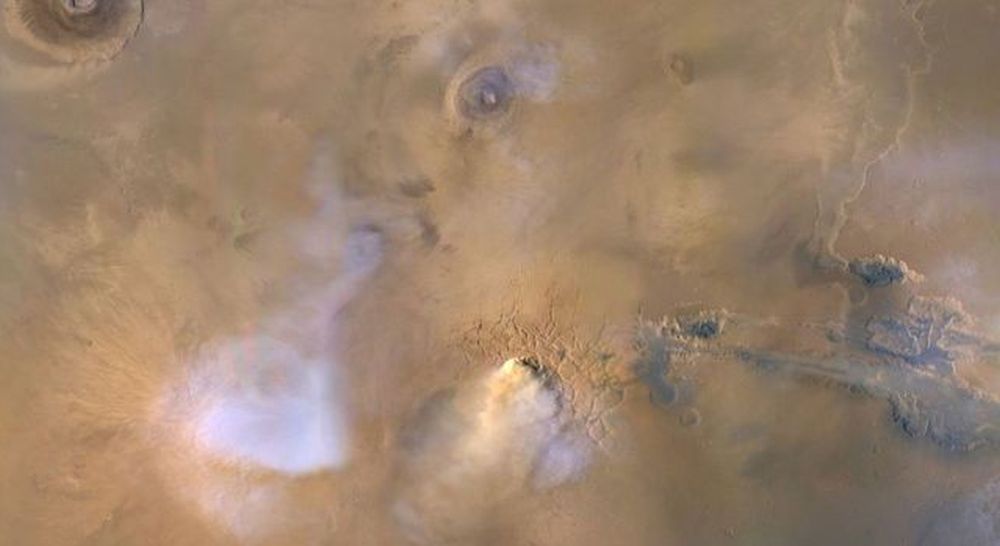Lightning is one of the most powerful forces in nature. Up to 1 billion volts of electricity can flow into a strike in less than a second. Such a large energy buildup can be created by even a relatively simple cause - two particles rubbing together. A team at the University of Oregon has now studied whether those simple interactions might cause lightning on a place it hasn't been seen before - on Mars.
The simple answer to that question is that yes, there will be some "lightning" on Mars during dust storms or other events with a lot of dust flying around, but it will not be anywhere near the scale of the storms seen on Earth. Mars’ atmosphere is too thin to hold the kind of voltages needed to create the dramatic lightning strikes common on Earth.
UT Video discussing the paucity of the atmosphere on Mars.However, there will still be much smaller electric discharge events. They might even be visible at very close range in certain wavelength, as dust storms can give off a faint glow when not in direct sunlight. That glow will mainly be in the form of radio waves, that are not detectable to the human eye.
Many researchers have tried to model the electrical activity of Mars' atmosphere before. UO's team took a different tack, accounting for many variables that confounded earlier efforts. They used a simple glass cylinder with dust particles inside of it. However, they made it a point to account for two different considerations that other experiments did not.
First, they electrically charged the cylinder itself, so that it would repel any dust used in the experiment. The cylinder itself was relatively small - four inches in diameter by eight inches in length. In the past, researchers had allowed dust to contact the glass cylinder, which was very unlike any material to be found on Mars itself. There were concerns that the ability to contact non-Martian materials would impact the results of the study.
Another challenge for previous experiments was using rock that was similar enough to that found on Mars. Joshua Méndez Harper, a research engineer and author on the paper, had relatively easy access to the type of volcanic rock similar to that on Mars as he works in the volcanology department at UO.
The combination of only Martian analog material in the cylinder as well as isolating it from any bordering non-Martian material means this is the closest researchers have yet come to truly modeling the environment on Mars electrically.
The crux of why the Martian atmosphere would not support the large lightning strikes seen on Earth is the paucity of its atmosphere. The electric fields the sparse Martian atmosphere can sustain run around twenty thousand volts per meter compared to three million volts per meter in Earth's much denser atmosphere.
Since lightning is a breakdown of the atmosphere itself, the higher the electric field it is subjected to the more spectacular the lightning. With the levels Mars' atmosphere is subjected to, it is likely to simply support small electrostatic discharges, similar to those you would experience by rubbing your socks on a carpet in the winter and touching a metallic door knob.
This is actually good news for Mars' current residents - rovers such as Perseverance and Curiosity can withstand the small electrical discharges allowed by the Martian atmosphere. With larger discharges, the conductive frame of the rovers could act like a lightning rod, with less than ideal consequences for the rovers themselves.
UT Video discussing Martian dust storms.The lack of lightning could also have a impact on the longer term colonization, though what impact that might be is unclear as of yet. Additionally, lightning does play a role in the creation of organic compounds. So far, it is not clear if the more dense Martian atmosphere of the past was capable of supporting the high energy bolts needed to create those organic compounds either.
For now we can say most likely Perseverance and the other rovers on the surface will not be the focal point of a visible lightning storm. But look closely with the right equipment and you might just be able to see a faint glow surrounding them.
Learn More:
UO - Mars rovers safe from lightning strikes, new UO research finds
NSF - Mars rovers safe from lightning strikes, research finds
UT - Lightning detected on Mars
Icarus - Detection of spark discharges in an agitated Mars dust simulant isolated from foreign surfaces
Lead Image:
Curiosity rover selfie.
Credit: NASA / JPL-Caltech / MSSS
 Universe Today
Universe Today



